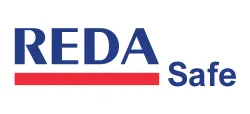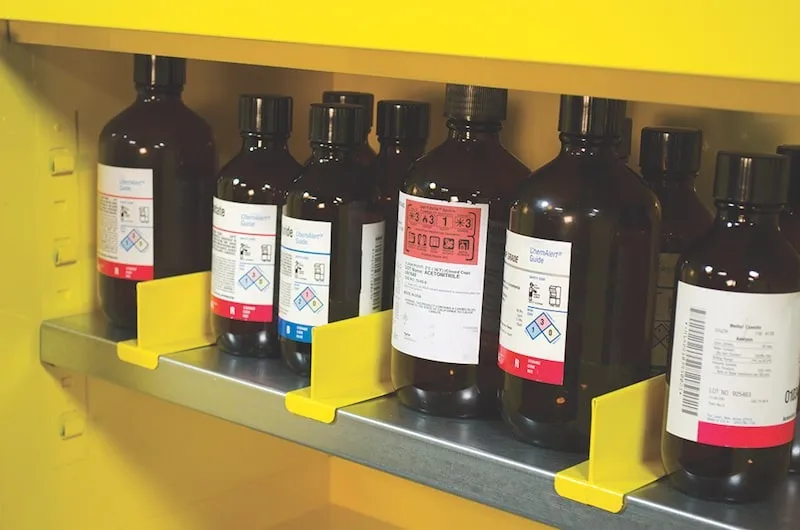Chemical Storage Rules
- Prevent sorting and storing chemicals alphabetically unless they have been separated into hazard classes.
- Ensure caps and lids on all chemical containers are closed tightly to prevent evaporation.
- Avoid storing chemicals on countertops or in fume hoods except those currently in use. In these locations chemicals are more readily knocked over; laboratory personnel chance of exposure is greatly increased, and the chemicals are unprotected if a fire were to occur in the laboratory.
- Reduce the possibility of spillage, by NOT storing chemicals on the floor.
- Use spill trays in situations, such as tissue culture vacuum lines, to contain chemical or media waste bottles.
- Date chemicals when received and when opened. If the chemical degrades in quality or becomes unsafe after prolonged storage, note the shelf-life expiration date.
- Maintain a permanent inventory and verify annually.
- Do not store chemicals (except cleaners) under sinks.
- Purchase only quantities that are needed to avoid stockpiling chemicals.
- Conduct periodic cleanouts to prevent accumulating unnecessary chemicals.
- Dispose properly or share with another research group chemicals that are no longer needed.
- Avoid exposing chemicals to heat or direct sunlight. This may lead to the deterioration of storage containers and labels, as well as the degradation of the chemicals.
- Store flammable materials (flammable liquids, flammable solids, etc) in a certified flammable safety cabinet. NEVER store flammable liquids in a domestic refrigerator. Only laboratory-safe, explosion-proof, or certified flammable liquid refrigerators can be used to store solvents.
Specific Chemical Storage Requirements
Acids
- Segregate oxidizing acids from organic acids, and flammable and combustible materials.
- Segregate acids from bases.
- Segregate acids from reactive metals such as sodium, potassium, and magnesium.
- Store acetic acid as a flammable liquid. This is an organic (carboxylic) acid that will react if it comes in contact with an oxidizing acid.
- Nitric acid and hydrochloric acid may be stored in the same corrosive storage cabinet, but they must be kept in separate drip trays. These can combine to form chlorine and nitrosyl chloride gases — both are toxic.
- Segregate acids from chemicals that could generate toxic or flammable gasses upon contact, such as sodium cyanide, iron sulfide, and calcium carbide.
Bases
- Segregate bases from acids, metals, explosives, organic peroxides and easily ignitable materials.
- Do not store aqueous sodium and potassium hydroxide solutions in aluminum drip trays. These will corrode aluminum.
Solvents (Flammable and Combustible Liquids)
- Store in approved safety cans or cabinets.
- Segregate from oxidizing acids and oxidizers.
- Keep away from any source of ignition: heat, sparks, or open flames.
- Only laboratory-safe, explosion-proof, or certified flammable liquid refrigerators can be used to store solvents. Never store flammable liquids in a domestic refrigerator.
Oxidizers
- Keep away from combustible and flammable materials.
- Keep away from reducing agents such as zinc, alkali metals, hydrazine, oxalic acid, and formic acid.
Cyanides
- Segregate from aqueous solutions, acids and oxidizers.
Water-Reactive Chemicals
- Store in a cool, dry place, away from any water source.
- Make certain that a Class D fire extinguisher is available in case of fire.
Pyrophoric Substances
- If in original container store in a cool, dry place, making provisions for an airtight seal.
- Store in a glove box after the material has been opened.
Light-Sensitive Chemicals
- Store in amber bottles in a cool, dry, dark place.
Peroxide-Forming Chemical Storage
- Most peroxide forming chemicals are also flammable liquids. Therefore, store in airtight containers in a flammable storage locker.
- Segregate from oxidizers and acids.
Toxic Chemicals Storage
- Store according to the nature of the chemical, using appropriate security where necessary.
Flammable Liquid Storage
All flammable and combustible liquids and solids must be stored in an appropriate manner to protect people and property from fire and explosion hazards. In CWRU laboratories, a net volume of two gallons (7.6 liters) of flammable liquids or solids must be stored in a certified flammable storage cabinet when it not in use.
Flammable storage cabinets are important to fire safety because they extend the amount of time it takes for fire to spread to other areas, thus allowing time to escape and time for fire responders to arrive. The following information can be found in the CWRU EHS Standard Operating Procedure for Flammable Safety Cabinets:
- Maximum allowed flammable liquids in a laboratory,
- Location of and storage of Flammable Storage Cabinets,
- Recommended size of Flammable Liquid Storage Cabinets for different amounts of material.
Why should solvents never be stored in a domestic refrigerator?
- A flammable liquid is defined, by the OSHA Hazard Communication Standard, as any liquid, which has a flashpoint at or below 93°C (200°F). (Flashpoint is the lowest temperature at which a liquid can form an ignitable mixture in air near the surface of the liquid. The lower the flash point, the easier it is to ignite the material.)
- Refrigerator temperatures are typically higher than the flash points of flammable liquids stored inside, therefore vapor accumulation can occur.
- There are a number of sources of ignition which are within or exposed to the refrigerated storage area of a standard domestic fridge such as thermostats, light switches, and heater strips.
- Vapors from flammable liquid spills or leaks can readily accumulate in the bottom of a refrigeration unit which is where the compressor and it's circuits are typically located.

